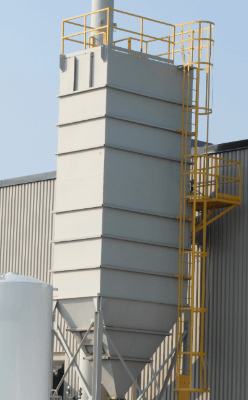What Is a Dust Collector?

A dust collector is a device used to collect dust and other particles.
It is used as a device to treat exhaust gas and dust. A household vacuum cleaner can also be classified as a dust collector if it is considered as a device to treat dust on the floor.
Uses of Dust Collectors
Dust collectors are used for both industrial and residential purposes. However, they differ in size and construction.
Specific applications are as follows:
- Exhaust gas equipment for boilers used in power generation
- Exhaust gas equipment for iron and steel plants and smelting plants
- Air cleaners and air conditioners with dust collectors
- Air cleaners for clean rooms
- Sawdust collection for woodworking workshops
- For cleaning dirty rooms
Principle of Dust Collectors
The majority of dust collectors on the market are centrifugal dust collectors. Centrifugal dust collectors rotate gas at high speed inside a cylindrical structure and collect dust to the sides by centrifugal force. They are easy to maintain and suitable for collecting relatively large dust particles.
Most household vacuum cleaners are based on the same principle as centrifugal dust collectors. Centrifugal dust collectors have the advantage of being compact and lightweight because of their simple structure and small number of parts.
Types of Dust Collectors
In addition to the centrifugal dust collectors described in the principle section, various other types of dust collectors are used in industrial applications. The following four types of dust collectors are typical.
1. Centrifugal Dust Collector (Cyclone)
As mentioned above, the principle is that centrifugal force is used to collect dust. However, the collection limit is about 10 μm, and it is not suitable for collecting particulates smaller than 10 μm. The equipment must be rotated, which causes mechanical strength problems and eccentricity, making it unsuitable for larger sizes.
2. Washing Type Dust Collector (Wet Scrubber)
A typical example of a cleaning dust collector is a scrubber. This device sprays a circulating liquid into exhaust gas and collects dust particles in the exhaust gas by the moisture of the circulating liquid. By controlling the PH of the circulating liquid, the chemical properties of the exhaust gas can be stabilized. However, it is necessary to use an additive device or additive agent regularly to keep the PH constant.
Dust collection performance is also high, and dust as small as 0.1 μm can be collected. However, the running cost is more expensive than other dust collectors.
3. Filtering Dust Collector (Fabric Filter)
The filtration type collects dust by passing exhaust gas through a filter cloth to which the dust adheres, effectively collecting particles as small as 0.1 μm in size and featuring high dust collection efficiency. On the other hand, the dust collection capacity tends to deteriorate due to clogging of the filter cloth, so periodic cleaning and replacement are required, and the running cost is high.
4. Electrostatic Dust Collector
Electrostatic dust collectors of a collecting plate and a discharging electrode, and collects particles using the Coulomb force acting on charged particles. The fine particles are charged by corona discharge at high voltage. The dust collection performance is capable of collecting more than 99% of submicron-level dust particles of about 0.05 μm.
In addition, because they are easy to maintain and have low running costs, electrostatic precipitator dust collectors have become the mainstream dust collectors for power generation plants in recent years. Electrostatic precipitator dust collectors are sometimes called a Cottrell after the developer.
Other Information on Dust Collectors
1. Dust Collectors and the Clean Air Act
Large dust collectors are used in industrial applications to treat exhaust gases. They are used in power plants, steel mills, and other plants with boilers and furnaces. Boilers and other equipment may cook with heavy oil or coal as fuel, and the exhaust gas contains a lot of carbon dust. This dust is called soot, and in the past, soot and dust have caused health problems.
Since exhausting soot and dust as it is leads to pollution, the laws stipulate that the soot and dust in exhaust gas be collected. In addition, each state has its own regulations on the amount of dust in factory exhaust gas, and dust collectors are used to meet these emission standards.
2. Dust Treatment of Dust Collectors
Dust collected by dust collectors is considered industrial waste for industrial use. Therefore, it cannot be disposed of in the open. The dust generated from boilers and other equipment is disposed of in landfills at final disposal sites registered with the government. Chips generated in the woodworking and forestry industries are sometimes used as valuable materials for biomass power generation.